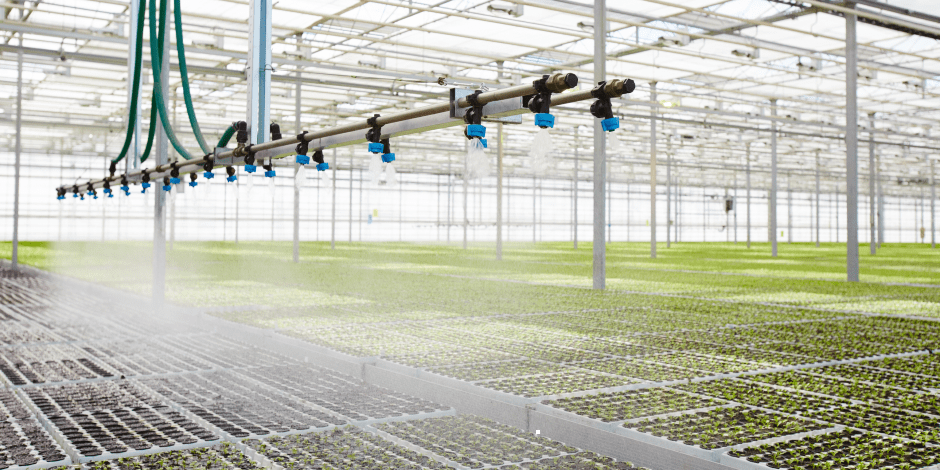High-Pressure Misting Pump vs. Fogging: What’s the Difference?

Shawn Glover, VP of Sales, Aug 3, 2021

At first glance, there doesn’t seem to be a big difference between high-pressure misting pumps and fogging pumps. Each consists of fine droplets produced with the right combination of flow, pressure, and nozzle size. But the difference is significant enough that it’s important to stress where they’re best suited and how to achieve each.
Here, we’ll cover how misting and fogging pumps differ — and how they might not — when it comes to droplet size, coverage, accuracy, and other factors to help you understand where each is best suited. We’ll also help you determine the right pump and nozzle size.
What’s the Difference Between Misting and Fogging?
It may seem an elementary question, but it’s important to first understand how misters and foggers differ. It mostly comes down to droplet size:
Fogging pumps produce ultra-small droplets, approximately 1–10 microns.
Misting pumps produce slightly larger droplet sizes, approximately 10–100 microns.
Because fog has smaller droplets, it basically floats into the air and randomly settles on surfaces without rhyme or reason. A fog doesn’t have enough mass to maintain consistent velocity through the air. It may help to envision the smoke coming from a cigar or the vapor from a boiling pot of water. Determining the trajectory of the fog or where it will land is nearly impossible. Simply put, fog lacks accuracy and goes wherever it wants to.
A mist, on the other hand, has droplets that are just large enough that they don’t “float” away. Instead, a misting pump can target its trajectory and direct the mist toward surfaces or areas with relative accuracy. This is critically important in applications where consistent coverage is required, such as herbicide applications where overspray could harm surrounding vegetation or result in non-compliance with environmental regulations.
Applications for High-Pressure Misting Pumps
Common applications for misting pumps include:
Outdoor Cooling. For outdoor venues, whether they be a large festival or your average patio, misting fans help bring relief from hot temperatures by way of evaporative cooling.
Dust Suppression. A fine mist forms a “curtain” or barrier within a zone. To overcome dust control challenges, you want the droplets to be similar in size to the dust particles so that they cling to them, so an understanding of the type of dust particles you’re working with is important.
Disinfection. Accurate coverage is critical when disinfecting surfaces to ensure all pathogens are destroyed. A mister can deliver precise control over the dispersion of chemicals, but it’s important to use a chemically compatible pump.
Greenhouses. When propagating small seedlings, a fine mist is perfect for helping to suppress fungal diseases and maintaining proper moisture levels in the growing medium, whereas a regular sprayer might damage fine plant tissues.
Pest Control. Combined with proper flow rates, pressure and nozzles, atomized mist droplets are dispensed accurately to ensure strict regulatory compliance for mosquito control and other pest control products.
Fertigation and Herbicide Application. Misting pumps allow for the dispensing of potentially harmful chemicals with pinpoint accuracy and consistent spray patterns to encourage optimal growing conditions.
Applications for High-Pressure Fogging Pumps
In general, the need for a fogger isn’t as common, but there are applications where it is desirable.
Humidity Control. Some environments require high humidity levels, from greenhouses to animal enclosures in zoos, and foggers are a great solution.
Special Effects. Whether it be a theatrical performance looking to mimic the streets of London or an outdoor water feature trying to create a tropical fog-like atmosphere, foggers help create visual interest.
The Importance of Choosing the Right Nozzle
The first step in achieving the desired coverage is choosing the right pump. If you don’t use a pump with the right PSI and flow rate, you’ll end up with bigger droplet sizes. Often, a pump will produce more flow than necessary, requiring the use of a regulator.
From there, however, parsing out the difference between producing a fog versus mist comes down to choosing the proper nozzle size. A fog requires a smaller nozzle than a mist.
To get the right droplet size, you need to build up enough back pressure, which is produced by the nozzle. It’s the combination of pressure, flow, and the nozzle working together that result in either a fog or mist. This stresses the importance of using a pump performance chart when determining which size nozzle to use.
Choosing the Best Misting and Fogging Pump
If you haven’t guessed by now, high-pressure pumps for fogging systems and high-pressure misting systems are typically one and the same. That said, you do need to choose a high-pressure pump designed to produce the right amount of flow and pressure, and choose the right nozzle to achieve the desired droplet size. The flow and pressure also need to be consistent without cycling or pressure spikes which result in poor coverage or “spitting” of droplets.
One of the best pumps for misting and fogging is the Pumptec 113C Series pump — originally developed to provide evaporative cooling in misting tents for the 1996 Atlanta Olympics. Its generally low flow rate of .25 GPM with pressure up to 1000 PSI combined with a .008 (.2mm) nozzle will produce perfectly sized atomized droplets for misting. Switching out the nozzle to a .004 (.1mm) will create even smaller droplets resulting in a fog.
The compact size and battery-operated capabilities of the 113C series pump make it ideal for stationary or handheld applications, and its durable design and components help ensure it will last for years to come. It can also be adapted for specific applications.
There are many benefits of misting pumps, but as you can see, there’s a lot to consider depending on your application. To learn about different types of pumps and where each is best suited, check out our Pump Comparison Cheat Sheet below. Then, speak with one of our pump experts to discuss flow rates, pressure, nozzle sizes, chemical compatibility, and other considerations when choosing a misting or fogging pump.



